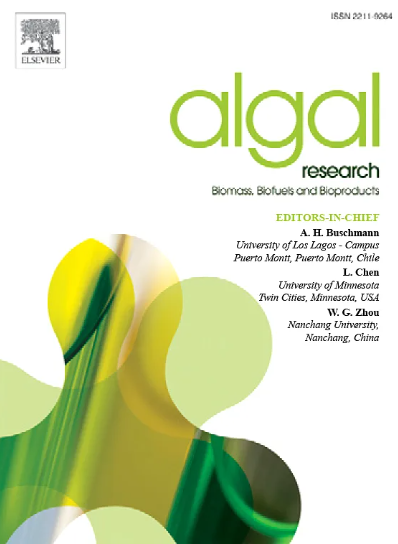Evaluation of the proximate composition and antioxidant capacity of some seaweeds from the Konkan coast of India
IF 4.6
2区 生物学
Q1 BIOTECHNOLOGY & APPLIED MICROBIOLOGY
Algal Research-Biomass Biofuels and Bioproducts
Pub Date : 2024-10-01
DOI:10.1016/j.algal.2024.103730
引用次数: 0
Abstract
Minerals, antioxidants, and other nutrients that promote health can be found in abundance in seaweeds. In this study, we evaluated the proximate composition and antioxidant capacity of some seaweeds from Konkan coast of India. There were notable differences in the proximate compositions between the species. The highest protein content was found in Pyropia vietnamensis (~49 mg. g−1 dw), whereas the highest carbohydrate (~83 mg. g−1 dw), lipids (56 mg. g−1 dw) and vitamins were found in Stoechospermum marginatum. Total phenolic content (TPC) and antioxidant activity were estimated from a Methanolic extracts. The antioxidant capacity of the seaweeds was evaluated using 1, 1-diphenyl-2-picrylhydrazyl (DPPH) radical scavenging, ABTS (2,2-azino-bis (3-ethylbenzothiazoline-6-sulfonic acid), ferric reducing antioxidant power (FRAP) assay and hydrogen peroxide free radical scavenging activity assay. Folin-Ciocalteu method was used to quantify total phenolic content (TPC), and Ulva fasciata had the highest TPC (24.30 ± 3 mg GAE. g−1 dry weight). In U. fasciata, the antioxidant activity was ~62 %, with an IC50 value of 0.057 ± 0.01 mM. Acanthophora spicifera was found to have a strong reducing power, with an IC50 value 0.012 ± 0.002 mM. H2O2 scavenging activity (~79 %) with an IC50 value of 0.006 ± 0.001 mM and 67 % ABTS radical scavenging activity (IC50 = 0.005) was highest in S. marginatum. Analysis showed that TPC exhibited strong positive correlation with both the ferric reducing antioxidant potential and DPPH antioxidant activity. These results showed that these seaweeds have significant antioxidant capacity and rich nutritional properties, which suggest they could be useful sources of functional ingredients for dietary supplements and other food products.
对印度康坎海岸一些海藻的近似成分和抗氧化能力的评估
海藻中含有丰富的矿物质、抗氧化剂和其他促进健康的营养物质。在这项研究中,我们评估了印度康坎海岸一些海藻的近似成分和抗氧化能力。不同物种之间的近似成分存在明显差异。Pyropia vietnamensis 的蛋白质含量最高(约 49 毫克/克-1 干重),而 Stoechospermum marginatum 的碳水化合物(约 83 毫克/克-1 干重)、脂类(56 毫克/克-1 干重)和维生素含量最高。从甲醇提取物中估算了总酚含量(TPC)和抗氧化活性。使用 1, 1-二苯基-2-苦基肼(DPPH)自由基清除法、ABTS(2,2-氮基-双(3-乙基苯并噻唑啉-6-磺酸))、铁还原抗氧化能力(FRAP)测定法和过氧化氢自由基清除活性测定法评估了海藻的抗氧化能力。采用 Folin-Ciocalteu 法对总酚含量(TPC)进行定量,结果表明 fasciata 莼菜的总酚含量最高(24.30 ± 3 mg GAE. g-1 干重)。在筋膜莼中,抗氧化活性约为 62%,IC50 值为 0.057 ± 0.01 mM。Acanthophora spicifera 具有很强的还原力,IC50 值为 0.012 ± 0.002 mM。S. marginatum 的 H2O2 清除活性(约 79%)最高,IC50 值为 0.006 ± 0.001 mM,ABTS 自由基清除活性(IC50 = 0.005)为 67%。分析表明,TPC 与铁还原性抗氧化潜能值和 DPPH 抗氧化活性均呈很强的正相关性。这些结果表明,这些海藻具有显著的抗氧化能力和丰富的营养特性,可作为膳食补充剂和其他食品的有用功能成分来源。
本文章由计算机程序翻译,如有差异,请以英文原文为准。
求助全文
约1分钟内获得全文
求助全文
来源期刊

Algal Research-Biomass Biofuels and Bioproducts
BIOTECHNOLOGY & APPLIED MICROBIOLOGY-
CiteScore
9.40
自引率
7.80%
发文量
332
期刊介绍:
Algal Research is an international phycology journal covering all areas of emerging technologies in algae biology, biomass production, cultivation, harvesting, extraction, bioproducts, biorefinery, engineering, and econometrics. Algae is defined to include cyanobacteria, microalgae, and protists and symbionts of interest in biotechnology. The journal publishes original research and reviews for the following scope: algal biology, including but not exclusive to: phylogeny, biodiversity, molecular traits, metabolic regulation, and genetic engineering, algal cultivation, e.g. phototrophic systems, heterotrophic systems, and mixotrophic systems, algal harvesting and extraction systems, biotechnology to convert algal biomass and components into biofuels and bioproducts, e.g., nutraceuticals, pharmaceuticals, animal feed, plastics, etc. algal products and their economic assessment
 求助内容:
求助内容: 应助结果提醒方式:
应助结果提醒方式:


